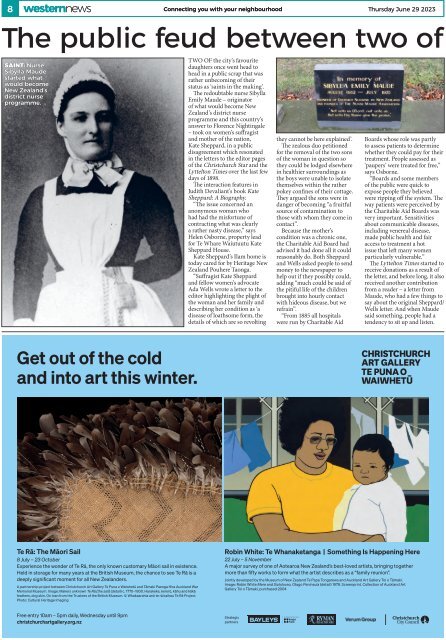Western News: June 29, 2023
You also want an ePaper? Increase the reach of your titles
YUMPU automatically turns print PDFs into web optimized ePapers that Google loves.
8<br />
Thursday <strong>June</strong> <strong>29</strong> <strong>2023</strong><br />
The public feud between two of<br />
SAINT: Nurse<br />
Sibylla Maude<br />
started what<br />
would become<br />
New Zealand’s<br />
district nurse<br />
programme.<br />
TWO OF the city’s favourite<br />
daughters once went head to<br />
head in a public scrap that was<br />
rather unbecoming of their<br />
status as ‘saints in the making’.<br />
The redoubtable nurse Sibylla<br />
Emily Maude – originator<br />
of what would become New<br />
Zealand’s district nurse<br />
programme and this country’s<br />
answer to Florence Nightingale<br />
– took on women’s suffragist<br />
and mother of the nation,<br />
Kate Sheppard, in a public<br />
disagreement which resonated<br />
in the letters to the editor pages<br />
of the Christchurch Star and the<br />
Lyttelton Times over the last few<br />
days of 1898.<br />
The interaction features in<br />
Judith Devaliant’s book Kate<br />
Sheppard: A Biography.<br />
“The issue concerned an<br />
anonymous woman who<br />
had had the misfortune of<br />
contracting what was clearly<br />
a rather nasty disease,” says<br />
Helen Osborne, property lead<br />
for Te Whare Waiutuutu Kate<br />
Sheppard House.<br />
Kate Sheppard’s Ilam home is<br />
today cared for by Heritage New<br />
Zealand Pouhere Taonga.<br />
“Suffragist Kate Sheppard<br />
and fellow women’s advocate<br />
Ada Wells wrote a letter to the<br />
editor highlighting the plight of<br />
the woman and her family and<br />
describing her condition as ‘a<br />
disease of loathsome form, the<br />
details of which are so revolting<br />
they cannot be here explained’.<br />
The zealous duo petitioned<br />
for the removal of the two sons<br />
of the woman in question so<br />
they could be lodged elsewhere<br />
in healthier surroundings as<br />
the boys were unable to isolate<br />
themselves within the rather<br />
pokey confines of their cottage.<br />
They argued the sons were in<br />
danger of becoming “a fruitful<br />
source of contamination to<br />
those with whom they come in<br />
contact”.<br />
Because the mother’s<br />
condition was a chronic one,<br />
the Charitable Aid Board had<br />
advised it had done all it could<br />
reasonably do. Both Sheppard<br />
and Wells asked people to send<br />
money to the newspaper to<br />
help out if they possibly could,<br />
adding “much could be said of<br />
the pitiful life of the children<br />
brought into hourly contact<br />
with hideous disease, but we<br />
refrain”.<br />
“From 1885 all hospitals<br />
were run by Charitable Aid<br />
Boards whose role was partly<br />
to assess patients to determine<br />
whether they could pay for their<br />
treatment. People assessed as<br />
‘paupers’ were treated for free,”<br />
says Osborne.<br />
“Boards and some members<br />
of the public were quick to<br />
expose people they believed<br />
were ripping off the system. The<br />
way patients were perceived by<br />
the Charitable Aid Boards was<br />
very important. Sensitivities<br />
about communicable diseases,<br />
including venereal disease,<br />
made public health and fair<br />
access to treatment a hot<br />
issue that left many women<br />
particularly vulnerable.”<br />
The Lyttelton Times started to<br />
receive donations as a result of<br />
the letter, and before long, it also<br />
received another contribution<br />
from a reader – a letter from<br />
Maude, who had a few things to<br />
say about the original Sheppard/<br />
Wells letter. And when Maude<br />
said something, people had a<br />
tendency to sit up and listen.<br />
Get out of the cold<br />
and into art this winter.<br />
Te Rā: The Māori Sail<br />
8 July – 23 October<br />
Experience the wonder of Te Rā, the only known customary Māori sail in existence.<br />
Held in storage for many years at the British Museum, the chance to see Te Rā is a<br />
deeply significant moment for all New Zealanders.<br />
A partnership project between Christchurch Art Gallery Te Puna o Waiwhetū and Tāmaki Paenga Hira Auckland War<br />
Memorial Museum. Image: Makers unknown Te Rā [the sail] (detail) c. 1770–1800. Harakeke, kererū, kāhu and kākā<br />
feathers, dog skin. On loan from the Trustees of the British Museum. © Whakaarahia anō te rā kaihau Te Rā Project.<br />
Photo: Cultural Heritage Imaging<br />
Robin White: Te Whanaketanga | Something Is Happening Here<br />
22 July – 5 November<br />
A major survey of one of Aotearoa New Zealand’s best-loved artists, bringing together<br />
more than fifty works to form what the artist describes as a “family reunion”.<br />
Jointly developed by the Museum of New Zealand Te Papa Tongarewa and Auckland Art Gallery Toi o Tāmaki.<br />
Image: Robin White Mere and Siulolovao, Otago Peninsula (detail) 1978. Screenprint. Collection of Auckland Art<br />
Gallery Toi o Tāmaki, purchased 2004<br />
Free entry 10am – 5pm daily, Wednesday until 9pm<br />
christchurchartgallery.org.nz<br />
Strategic<br />
partners


















